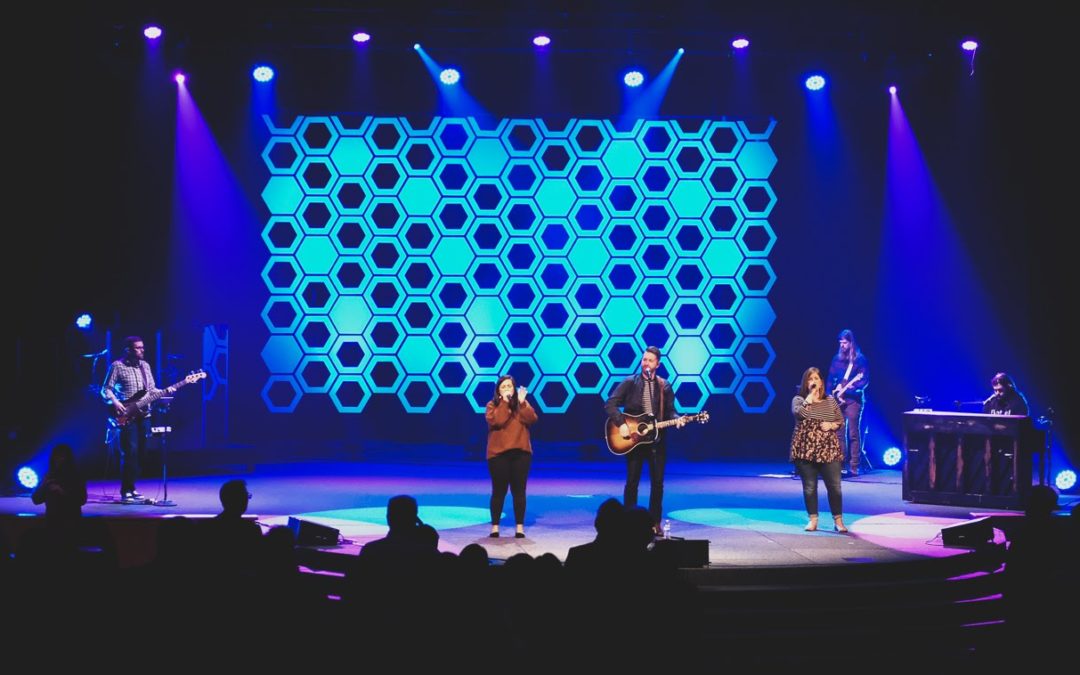Welcome to episode 1 46 of the Mod Scenes podcast. I’m thrilled to be chatting with you about our, uh, stage design, uh, stages on products, specifically our stage backdrops and DMX voice, uh, today. Uh, although we normally talk about a lot of stage design products and specifically stage backdrops on this show, uh, today I want to take a little bit different direction and talk specifically through our DMX voice, um, and specifically through network control for our DMH one, DMX was, uh, so, uh, our DMX voice are obviously, uh, more of a lighting product than a stage backdrop product. Uh, they are super cool, uh, super cool, uh, lighting element. They can move up and down in 3d space. Uh, they are controlled via a standard lighting console and a really, really cool, uh, fixture for, uh, creating a great amount of movement and energy inside of your design. So, um, um, and also, sorry, forgot to mention they’re both available for rental land purchase, uh, and you can rent or purchase those@mazzianz.com. So, um, so unlike a stage backdrops, uh, there are additional pieces needed whenever you, uh, put together a geometric voice system. Uh, so whenever we’re putting together a Connecticut light system, uh, of the DMX boys, uh, you always want to make sure that your data network
Is set up well. So specifically your GMX network. So, uh,
This is a best practice. And, uh, so I’m going to describe the best practice, uh, way to set up a DMX voice system, specifically the control network. Um, it’s not the only way to do it, but this is the way that we do it because, uh, it sets everything up for the best possible, uh, best possible outcome.
Um, so, uh, let’s start with the console. So anytime you’re using the DMX voice, you need to use a reliable content. It’s not going to
Output Aaron data. So what I mean by year end data is that’s not going to flicker or put out, uh, DMX values, um, above zero. Uh, if it isn’t like when you restart it or something like that, um, that does happen on some older consoles and some less professional consoles. So always make sure you’re using a console that is from a reputable manufacturer, uh, that works well. Um, so you’ll output your DMX. Uh, we always use five Ben. Um, you can use five or three pin, but just ensure that it’s DMX cable, uh, TMX cable is different than my cable because as a different impedance. Uh, so you always want to make sure you’re using DMX cable because it will, uh, uh, if you have my cable instead of cable, the impedance is wrong. And a lot of times you can have issues with your DMX data, uh, in an, a network of DMX voice.
If you have issues with the DMX data, it can force your DMX poised to move, um, incorrectly, which is obviously not a good thing. Um, these, the hoist don’t have very much weight, uh, the maximum weight that, uh, you would put up the end of this poison is three pounds, but still three pounds moving down 30 feet quickly. Uh, you know, as soon as the motor OLED, it is still not great. Um, so you want to make sure that you’re using actual DMX. Uh, I really liked the Lex pro, um, series of DMX and also the, um, the proplex from TMB. Both of those are really good. Uh, really sturdy cables really well-built have the correct impedance. Um, and we’ve also used the Accu cable pro series and it’s, uh, it’s okay. Uh, it works fine. Uh, it’s not quite as durable, but it is, uh, it is functional. So, uh, if you’re, if you’re looking to, um, if you’re looking at different options, those are a couple of different options on the DMX. And, uh, and another thing I’d mentioned is any type of jumpers
That are needed for our systems. Whenever we do a rental, we always include all of that. So it’s kind of a, it’s a whole package. You just plug in your input data and your power and start running. So, um, so, uh, onto data distribution. So, um, the DMX protocol,
So DMS five health protocol, uh, allows for 32 fixtures per DMX run. So, um, whenever you’re doing a DMX voiced, um, voice set up, sometimes there’ll be 32 fixtures, but on quite a few occasions, we’ll have more than that many fixtures. Uh, one of the last events we just did was like 80 fixtures. So with that, um, you want to kind of split up your, uh, split up your rig into multiple segments of data. Uh, the best way to do this is the room opto splitter. So you send that your initial data out of your console, uh, to a, um, opto splitter. And what Optiv splitter does is it will split the, um, it will split the DMX signal. It will actually make copies of it,
Uh, uh, through, and it’ll transmitted through, um, through an optical sensor. So if you do have bad data on one of the lines, it won’t affect the other lines. So what we try to do is we try to, um, try to separate, uh, our systems in, uh, lines. That makes
Sense. So, for example, uh, we did have him for Chick-fil-A not too long ago where we ran all of our data, um, on the trusses, like per tries. So we had seven trusses and on those seven trusses, each one had its own data line that ran to, uh, a DMX, uh, opto splitter. So that way, if one trust went down, uh, our other trusses would be fine. Um, we didn’t have any issues like that as we mentioned, because we did the best practices using, uh, using real, uh, heightened, uh, real impedance, uh, corrected pittance, DMX cable. Um, we made sure all of our, all of our cables were working order as we’re going. There was nothing that was like, uh stage backdrops, messed up. So, um, so yeah, so, uh, continuing on the best practices for networking, um, let’s see the other, um, so we typically try to split at least every 20.
So if we have 80 units, we’ll do at least four data runs to an auto splitter. Uh, and it’s important whenever you’re using your off the splitter to always use the opto outputs. So these are the isolated outputs. Um, it’s important not to use that through cause the through does nothing. It actually, uh, it’s just a hard line DMX directly to your main line DMX. So if you use the through and there’s an issue on that through line, it will affect all of their lines. So you don’t want that. You want to make sure that you’re always, you never use that through on your DMX opto. You always use the, uh, the isolated outputs of your opto splitter. So, uh, let’s see what else. Um, we also do the same thing with, uh, our power cable. So all of our power and data are in looms, so they easily clipped together.
Uh, just click, click, click into each fixture. Uh, so it’s really easy for us to separate out segments of the rig into different, uh, blocks. So total we have a total, we have, uh, you can put up to up to 20 fixtures on a single power source. We typically do 10. Uh, just cause again, if the cable goes down, um, it takes out everything that’s in the chain. So we, uh, we typically try to do just do 10 cause it’s easy. We’ll do like a single soccer packs up, up in the ceiling and do 10 to 15, uh, on, on occasion, we’ll do 20, but we try not to, uh, just cause it, uh, it’s better practice to do 10 because if something happens, then you’ll only lose a portion of your rig. Um, so yeah, so in, in all of this, um, obviously these are, uh, these are, uh, more of like best practices for stage backdrops.
These are best practices, uh, for if something did happen. Uh, our pictures are super great. We haven’t had these kinds of issues, uh, but we always set up a play plan for the word play. We always plan for the worst and, uh, get the best by doing so. Um, so yeah. Um, so yeah, so I hope this has been a helpful look into, uh, some of the, uh, some of the things you can do with, uh, uh, DMX voice, um, with our DMX voice. Uh, some people would refer to them as kinetic lights, uh, or like DMX winches, um, as you can see, there’s a lot of good practices you can put into place. Um, so yeah, so I’d love to chat with you on, um, on more specifics about our DMX voice, feel free to call our office. And I loved it to, to start up a conversation with you about this, uh, our, you can reach us at 5 3 0 7 2 3 6 4 2 1, uh, or you can also email us@salesmodscenes.com. Uh, and if you have any questions, if you have any questions, obviously reach out. Um, but, uh, keep, keep checking out the podcast. We have more, uh, more podcasts about stage backdrops and creating greatest church stage designs coming up. And I’d love to, uh, I’d love for you to listen to those and learn a little bit more about our products and our services, uh, so we can serve you best again. I thank you for, uh, thank you for allowing us to serve you and we’re thrilled to serve you soon.


Recent Comments